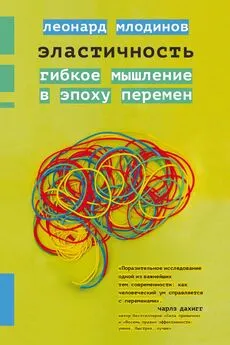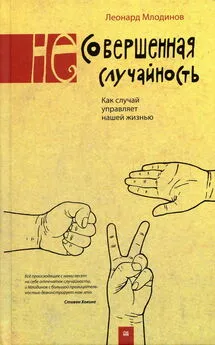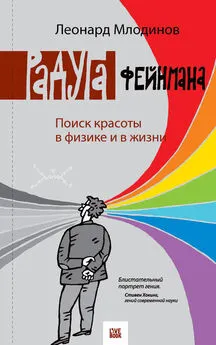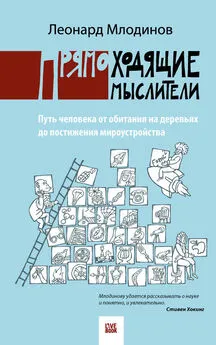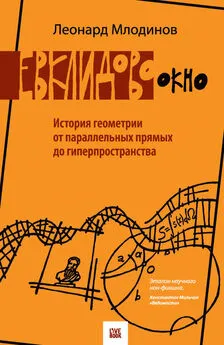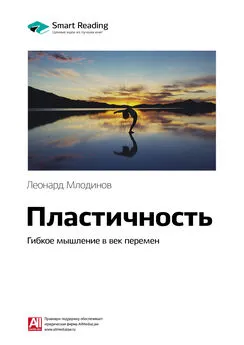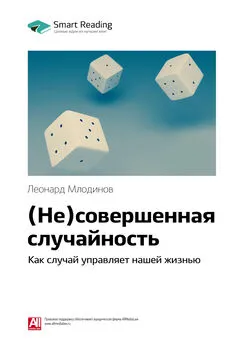Леонард Млодинов - Эластичность. Гибкое мышление в эпоху перемен
- Название:Эластичность. Гибкое мышление в эпоху перемен
- Автор:
- Жанр:
- Издательство:Livebook/Гаятри
- Год:2020
- Город:Москва
- ISBN:978-5-907056-30-5
- Рейтинг:
- Избранное:Добавить в избранное
-
Отзывы:
-
Ваша оценка:
Леонард Млодинов - Эластичность. Гибкое мышление в эпоху перемен краткое содержание
Существует два основных способа мышления: аналитическое, в котором преобладает логика, и эластичное, которое формирует новые идеи и неожиданные решения задач. Именно эластичное мышление позволяет человеку успешно приспосабливаться к безумному ритму жизни.
Из книги вы узнаете: почему полезно выходить из зоны комфорта; как справляться с огромным количеством информации и не сойти с ума; как мозг создает смыслы и учится адаптации; как Мэри Шелли, Дэвид Боуи и Альберт Эйнштейн использовали эластичное мышление; почему игра Pokemon Go обрела небывалую популярность.
Эластичность. Гибкое мышление в эпоху перемен - читать онлайн бесплатно ознакомительный отрывок
Интервал:
Закладка:
141
Джон Куниос, из беседы с автором 23 февраля 2015 г.
142
Марк Бимен, из беседы с автором 23 февраля 2015 г.
143
Конан Кристофер О’Брайен (род. 1963) – американский комик с ирландскими корнями, телеведущий, сценарист. Кристофер Морис «Крис» Браун (род. 1989) – американский рэп-, хип-хоп- и ритм-н-блюзовый музыкант, актер.
144
Conan, TBS, 16 марта 2015 г.
145
E. M. Bowden, M. J. Beeman, “Getting the Idea Right: Semantic Activation in the Right Hemisphere May Help Solve Insight Problems”, Psychological Science 9 (1998): 435–440.
146
RAT – Remote Association Test. По-англ. «rat» – крыса.
147
Compound Remote Associate Problems (CRAP). Слово «grap» по-англ. – дерьмо, фуфло, чепуха.
148
Русскоязычный эквивалент этого теста предполагает свободу грамматических форм всех участвующих слов и не требует, чтобы слово-ключ присоединялось к исходным словам и образовывало с ними сложносоставные, поэтому решение всей задачи, приводимое далее, действительно только в английском языке (очевидно, словосочетание «мясной соус» в русском языке совершенно обыденно, например).
149
Котлета из крабового мяса ( англ .), букв. «крабовый пирог».
150
Образуются слова pineapple (ананас, англ .), crabapple (яблоко-дичок, англ .), applesauce (яблочный соус, а также чушь, лесть или враки, англ .).
151
Mark Jung-Beeman et al., “Neural Activity When People Solve Verbal Problems with Insight”, PLOS Biology 2 (апрель 2004 г.): 500–507.
152
Simon Moss, “Anterior Cingulate Cortex”, Sicotests, http://www.psych-it.com.au/Psychlopedia/article.asp?id=263; Carola Salvi et al., “Sudden Insight Is Associated with Shutting Out Visual Inputs”, Psychonomic Bulletin and Review 22, № 6 (декабрь 2015 г.): 1814–1819; John Kounios, Mark Beeman, “The Cognitive Neuroscience of Insight”, Annual Review of Psychology 65 (2014): 1–23.
153
John Kounios, Mark Beeman, The Eureka Factor: Aha Moments, Creative Insight, and the Brain (Нью-Йорк: Random House, 2015), 195–196.
154
Lorenza S. Colzato et al., “Meditate to Create: The Impact of Focused-Attention and Open-Monitoring Training on Convergent and Divergent Thinking”, Frontiers in Psychology 3 (2012): 116.
155
Richard Chambers et al., “The Impact of Intensive Mindfulness Training on Attentional Control, Cognitive Style, and Affect”, Cognitive Therapy and Research 32 (2008): 303–322.
156
J. Meyers-Levy, R. Zhou, “The Influence of Ceiling Height: The Effect of Priming on the Type of Processing That People Use”, Journal of Consumer Research 34 (2007): 1741–1786.
157
R. L. Dominowski, P. Dollob, “Insight and Problem Solving”, в: The Nature of Insight, сост. R. J. Sternberg, J. E. Davidson (Кембридж, Массачусетс: MIT Press, 1995), 33–62.
158
Tim P. German, Margaret Anne Defeyter, “Immunity to Functional Fixedness in Children”, Psychonomic Bulletin and Review 7 (2000): 707–712.
159
Tim P. German, H. Clark Barrett, “Functional Fixedness in a Technologically Sparse Culture”, Psychological Science 16b (2005): 1–5.
160
John Maynard Keynes, General Theory of Employment, Interest and Money (Нью-Йорк: Harvest/Harcourt, 1936), vii. [Цит. по изд.: Кейнс Джон Мейнард. Общая теория занятости, процента и денег. Избранное. М.: ЭКСМО, 2007. – Примеч. перев. ]
161
James Jeans, “A Comparison Between Two Theories of Radiation”, Nature 72 (27 июля 1905 г.): 293≠294.
162
Hannah Arendt, “Thinking and Moral Considerations”, Social Research 38 (осень 1971 г.): 423.
163
Milton Meltzer, Dorothea Lange: A Photographer’s Life (Сиракьюз, Нью-Йорк: Syracuse University Press, 2000), 140. [Доротея Ланж (1895–1965) – американский фотограф, фотожурналистка, классик мировой документальной фотографии. – Примеч. перев. ]
164
B. Jena Anapam et al., “Mortality and Treatment Patterns Among Patients Hospitalized with Acute Cardiovascular Conditions During Dates of National Cardiology Meetings”, JAMA Internal Medicine 10 (2014): E1–E8.
165
Merim Bilalic2, Peter McLeod, “Why Good Thoughts Block Better Ones”, Scientific American 310 (3 января 2014 г.): 74–79.
166
Doron Garfinkel, Sarah Zur-Gil, H. Ben-Israel, “The War Against Polypharmacy: A New Cost-Effective Geriatric-Palliative Approach for Improving Drug Therapy in Disabled Elderly People”, Israeli Medical Association Journal 9 (2007): 430.
167
Erica M. S. Sibinga Albert W. Wu, “Clinician Mindfulness and Patient Safety”, Journal of the American Medical Association 304 (2010): 2532–2533.
168
Слова Маккристэла здесь и далее – из его беседы с автором 13 января 2016 г.
169
Дэвид Петреус, из беседы с автором 16 февраля 2016 г.
170
См., например: Abraham Rabinovich, The Yom Kippur War: The Epic Encounter That Transformed the Middle East (Нью-Йорк: Schocken Books, 2004); David T. Buckwalter, “The 1973 Arab-Israeli War”, в: Case Studies in Policy Making & Process, сост. Shawn W. Burns (Ньюпорт, Род-Айленд: Naval War College, 2005), 17; Uri Bar-Joseph, Arie W. Kruglanki, “Intelligence Failure and the Need for Cognitive Closure”, Political Psychology 24 (2003): 75–99.
171
«Green Bay Packers» (осн. 1919) – профессиональный клуб американского футбола из города Грин-Бей, Висконсин.
172
Джеймз Уорнер, из беседы с автором 14 декабря 2015 г.
173
Dan Schwabel, “Stanley McChrystal: What the Army Can Teach You About Leadership”, Forbes, 13 июля 2015 г.
174
Bilalic2, McLeod, “Why Good Thoughts Block Better Ones”, 74–79; Merim Bilalic2 et al., “The Mechanism of the Einstellung (Set) Effect: A Pervasive Source of Cognitive Bias”, Current Directions in Psychological Science 19 (2010): 111–115.
175
В положении на левой доске возможно привычное решение так называемого «спертого мата»: (1) Qe6+ Kh8 (2) Nf7+ Kg8 (3) Nh6++ Kh8 (4) Qg8+ Rxg8 (5) Nf7#. Решение короче и оптимальнее: (1) Qe6+ Kh8 (2) Qh6 Rd7 (3) Qxh7#, or (2)… Kg8 (3) Qxg7#. В положении на правой доске спертый мат невозможен, поскольку черный слон занимает клетку f7. Оптимальное решение по-прежнему возможно: (1) Qe6+ Kh8 (If (1)… Kf8, 2 Nxh7#) (2) Qh6 Rd7 (3) Qxh7#, or (2)… Kg8 (3) Qxg7#, or (2)… Bg6 (3) Qxg7#. From Bilalic2, et al., “Why Good Thoughts Block Better Ones: The Mechanism of the Pernicious Einstellung Effect”, Cognition 108 (2008): 652–661.
176
Victor Ottati et al., “When Self-Perceptions Increase Closed-Minded Cognition: The Earned Dogmatism Effect”, Journal of Experimental Social Psychology 61 (2015): 131–138.
177
Там же.
178
Serge Moscovici, Elisabeth Lage, Martine Naffrechoux, “Influence of a Consistent Minority on the Responses of a Majority in a Color Perception Task”, Sociometry 32, № 4 (1969): 365–380.
179
C. J. Nemeth, “Minority Influence Theory”, в: Handbook of Theories of Social Psychology, сост. P. Van Lange, A. Kruglanski, T. Higgins (Нью-Йорк: Sage, 2009).
180
Uri Bar-Joseph, Arie W. Kruglanki, “Intelligence Failure and the Need for Cognitive Closure”, Political Psychology 24 (2003): 75–99.
181
Ap Dijksterhuis, “Think Different: The Merits of Unconscious Thought in Preference Development and Decision Making”, Journal of Personality and Social Psychology 87 (2004): 586–598.
182
Piggly wiggly – задорный поросенок ( англ .).
183
T. C. Kershaw, S. Ohlsson, “Multiple Causes of Difficulty in Insight: The Case of the Nine-Dot Problem”, Journal of Experimental Psychology: Learning, Memory, and Cognition 30 (2004): 3–13; R. W. Weisberg, J. W. Alba, “An Examination of the Alleged Role of Fixation in the Solution of Several Insight Problems”, Journal of Experimental Psychology: General 110 (1981): 169–192.
184
James N. MacGregor, Thomas C. Ormerod, Edward P. Chronicle, “Information Processing and Insight: A Process Model of Performance on the Nine-Dot and Related Problems”, Journal of Experimental Psychology: Learning, Memory, and Cognition 27 (2001): 176.
185
Ching-tung Lung, Roger L. Dominowski, “Effects of Strategy Instructions and Practice on Nine-Dot Problem Solving”, Journal of Experimental Psychology: Learning, Memory, and Cognition 11, № 4 (январь 1985 г.): 804–811.
186
Richard P. Chi, Allan W. Snyder, “Brain Stimulation Enables the Solution of an Inherently Difficult Problem”, Neuroscience Letters 515 (2012): 121–124.
187
Там же.
188
См. например: Carlo Cerruti, Gottfried Schlaug, “Anodal Transcranial Stimulation of the Prefrontal Cortex Enhances Complex Verbal Associative Thought”, Journal of Cognitive Neuroscience 21 (октябрь 2009 г.); M. B. Iyer et al., “Safety and Cognitive Effect of Frontal DC Brain Polarization in Healthy Individuals”, Neurology 64 (март 2005 г.): 872–875; Carlo Reverbi et al., “Better Without (Lateral) Frontal Cortex? Insight Problems Solved by Frontal Patients”, Brain 128 (2005): 2882–2890; Arthur P. Shimamura, “The Role of the Prefrontal Cortex in Dynamic Filtering”, Psychobiology 28 (2000): 207–218.
Читать дальшеИнтервал:
Закладка:
